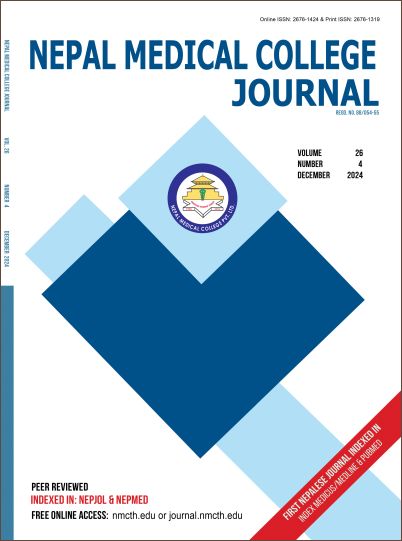Repeat CT Brain in Mild Traumatic Brain Injury with Intracerebral Hemorrhage
DOI:
https://doi.org/10.3126/nmcj.v26i4.74458Keywords:
Clinical outcomes, Glasgow coma scale, intracranial hemorrhage, repeat CTAbstract
Traumatic brain injury (TBI) is a significant public health concern, and the role of repeat computed tomography (CT) scans in managing TBI remains a critical area of investigation. This study evaluates the utility of repeat CT scans in detecting clinically significant changes that necessitate intervention and impact patient outcomes. The aim of this prospective study was to assess the clinical value of repeat CT scans in TBI patients by analyzing patient demographics, initial and repeat CT findings, surgical interventions, and short-term outcomes. The study included 200 patients with TBI who underwent both initial and repeat CT scans at Kathmandu Medical College Teaching Hospital between January 2022 and December 2023. The mean age of the cohort was 45.3 ± 18.6 years, with a male predominance (70%). The initial Glasgow Coma Scale (GCS) scores categorized 65% of patients with mild TBI (GCS 13-15), 25% with moderate TBI (GCS 9-12), and 10% with severe TBI (GCS ≤8). Repeat CT scans were performed based on clinical indications such as deterioration, new symptoms, or for routine follow-up. Statistical analyses included paired t-tests, chi-square tests, and logistic regression, with significance defined as p < 0.05. The initial CT scans revealed intracranial hemorrhages in 60% of patients, with subdural hematomas being the most common (40%). Repeat CT scans identified new or worsening hemorrhages in 30% of patients, leading to surgical intervention in 25%, primarily through hematoma evacuation (60%) and decompressive craniectomy (40%). Paired t-tests demonstrated a statistically significant difference between initial and repeat CT findings (p <0.01). Chi-square tests indicated a significant association between clinical deterioration and the need for repeat CT (p <0.05). Logistic regression analysis identified the initial GCS score (OR: 2.5, 95% CI: 1.5-4.1), type of hemorrhage (OR: 1.8, 95% CI: 1.2-2.9), and the presence of skull fractures (OR: 2.2, 95% CI: 1.3-3.7) as predictors of surgical intervention following repeat CT scans. This study underscores the importance of repeat CT scans in TBI management, particularly for patients with severe injuries or clinical deterioration, where it influences surgical decisions and patient outcomes. The findings advocate for a selective imaging approach, optimizing resource use while ensuring patient safety.
Downloads
Downloads
Published
How to Cite
Issue
Section
License
Copyright (c) 2024 Nepal Medical College Journal

This work is licensed under a Creative Commons Attribution 4.0 International License.
This license enables reusers to distribute, remix, adapt, and build upon the material in any medium or format, so long as attribution is given to the creator. The license allows for commercial use.




